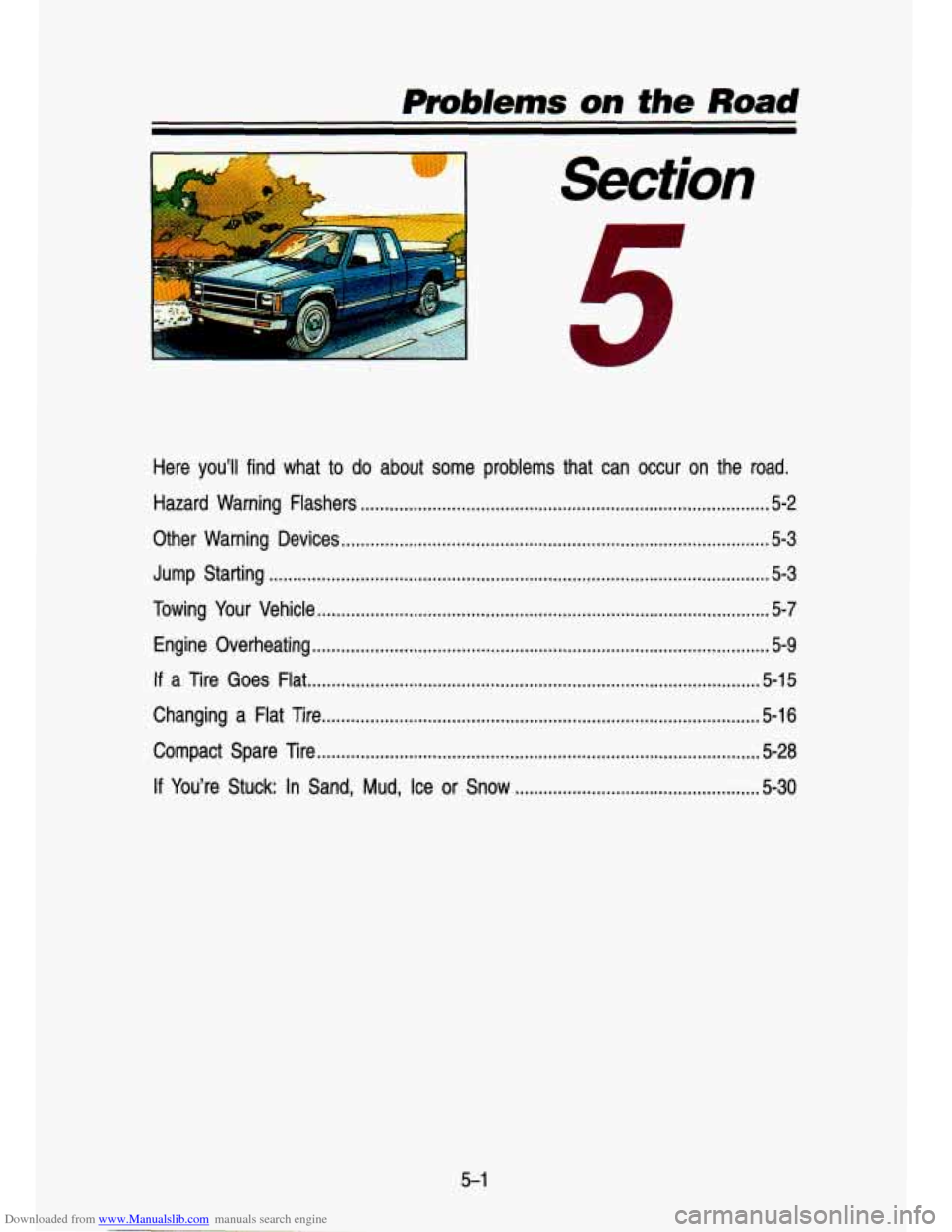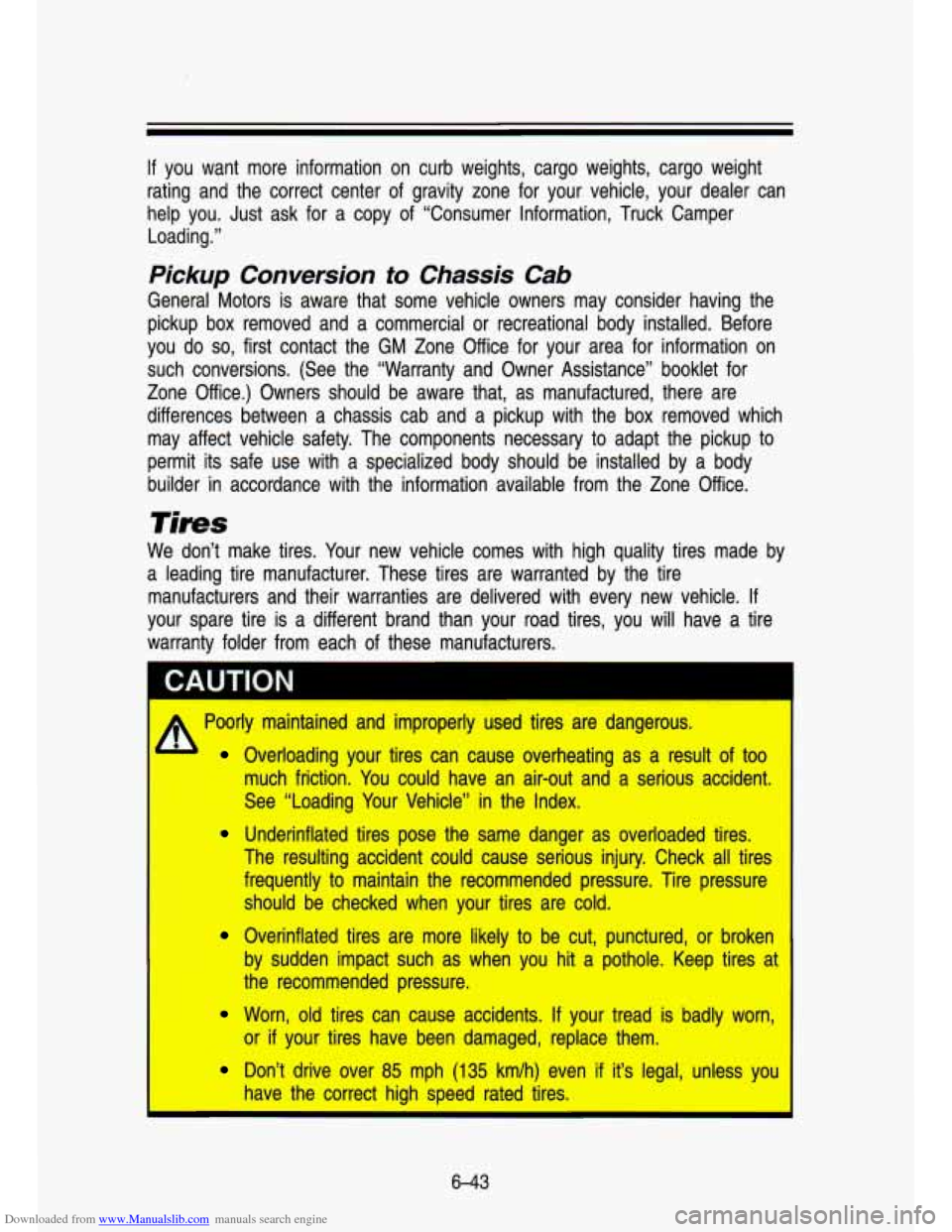Page 7 of 356

Downloaded from www.Manualslib.com manuals search engine Section
I
This section tells you how to use your manual and includes
safety and vehicle damage warnings and symbols.
‘II
This section tells you how to use your seats and safety belts
1 properly.
This section explains how to start and operate your vehicle.
’ This section tells you how to adjust the ventilation and comfort
controls and how to operate your audio system,
Here you’ll find helpful information and tips about the road and
how to drive under different conditions.
This section tells you what to
do if you have a problem while
driving, such as a
flat tire or engine overheating.
’ Here the manual tells you how to keep your vehicle running
properly and looking good.
7
This section tells you when to perform vehicle maintenance and
what fluids and lubricants to use.
~ ~~~~~ ~ ~ ~
1 This section tells you how to contact your GM division for
assistance and how to get service publications.
It also gives
you information on “Reporting Safety Defects”,
Here’s an alphabetical listing of almost every subject in this
I manual. You can line it to quickly find something you want to
Illrcl. read.
TO21 0
V
Page 217 of 356

Downloaded from www.Manualslib.com manuals search engine prOb/ems on the Road
. .-
r
7
Here you’ll find what to do about some problems that can occur on the road .
Hazard Warning Flashers ........................................................................\
............. 5-2
Other Warning Devices ........................................................................\
................. 5-3
Jump Starting ........................................................................\
................................ 5-3
Towing Your Vehicle ........................................................................\
...................... 5-7
Engine Overheating ........................................................................\
....................... 5-9
If a Tire Goes Flat ........................................................................\
...................... 5-15
Changing a Flat Tire ........................................................................\
................... 5-16
Compact Spare Tire ........................................................................\
.................... 5-28
If You’re Stuck: In Sand, Mud, Ice or Snow ................................................... 5-30
Page 225 of 356
Downloaded from www.Manualslib.com manuals search engine Engine Overheating
You will find a coolant temperature gage on your vehicle inslrument panel.
If Steam IS Coming From Your Engine:
. ,, ..;., .. ,., - , . I ~ &<4g&&$': $&$&&%,+ I , $.$ .?,'$;;$ ;,";,&,.,.&
..
KO71 4
1 ,A Steam from an overheated engine can burn you badly, even if you
just open the hood. Stay away from the engine
if you see or hear
steam coming from it. Just turn it
off and get everyone away from
the vehicle until it cools down. Wait until there is no sign of steam or
coolant before opening the hood.
If you keep driving when your engine is overheated, the liquids in it
can catch fire. You or others could be badly burned. Stop your
engine
if it overheats, and get out of the vehicle until the engine is
I cool.
NCITICE
5-9
Page 271 of 356

Downloaded from www.Manualslib.com manuals search engine How to Check Lubricant:
i I
KO998
If the level is below the bottom of the filler plug hole, you’ll need to add
some lubricant.
If the differential is at operating temperature (warm), add enough lubricant to
raise the level
to the bottom of the filler plug hole.
If the differential is cold, add enough lubricant to raise the level to 1/2 inch
(12 mm) below the filler plug hole.
What to Use:
Refer to the Maintenance Schedule to determine what kind of lubricant to
use. See “Recommended Fluids and Lubricants” in the Index.\
Engine Coolant
The following explains your cooling system and how to add coolant when it is
low.
If you have a problem with engine overheating, see “Engine
Overheating’’ in the Index.
The proper coolant
for your vehicle will:
Give freezing protection down to -20°F (-29°C) or -34°F (-37°C) for
Give boiling protection up to 258°F (125°C).
Canadian vehicles and vehicles with the cold climate option.
Protect against rust and corrosion.
Help keep
the proper engine temperature.
Let the warning lights and gages work as they should.
6-23
Page 291 of 356

Downloaded from www.Manualslib.com manuals search engine If you want more information on curb weights, cargo weights, cargo weight
rating and the correct center of gravity zone for your vehicle, your dealer can
help you. Just ask for a copy of “Consumer Information, Truck Camper
Loading.”
Pickup Conversion fo Chassis Cab
General Motors is aware that some vehicle owners may consider having the
pickup box removed and a commercial or recreational body installed. Be\
fore
you do
so, first contact the GM Zone Office for your area for information on
such conversions. (See the “Warranty and Owner Assistance”\
booklet for
Zone Office.) Owners should be aware that, as manufactured, th\
ere are
differences between a chassis cab and a pickup with the box r\
emoved which
may affect vehicle safety. The components necessary to adapt the pickup to
permit its safe use with a specialized body should be installe\
d by a body
builder in accordance with the information available from the Zone Office.
Tires
We don’t make tires. Your new vehicle comes with high quality tires made by
a leading tire manufacturer. These tires are warranted by the tire
manufacturers and their warranties are delivered with every new vehicle. If
your spare tire is a different brand than your road tires, you will have a tire
warranty folder from each of these manufacturers.
4 Poorly maintained and improperly used tires are dangerous.
Overloading your tires can cause overheating as a result of too
much friction. You could have an air-out and a serious accide
See “Loading Your Vehicle” in the Index.
Underinflated tires pose the same danger as overloaded tires.
The resulting accident could cause serious injury. Check all tires
frequently to maintain the recommended pressure. Tire pressure should be checked when your tires are cold.
I
Overinflated tires are more likely to be cut, punctured, or broken
by sudden impact such as when you hit a pothole. Keep tires ar
I the recommended pressure.
Worn, old tires can cause accidents. If your tread is badly worn, I
Don’t drive over 85 mph (135 km/h) even if it’s legal, unless you
or
if your tires have been damaged, replace them.
have the correct high speed rated tires.
6-43